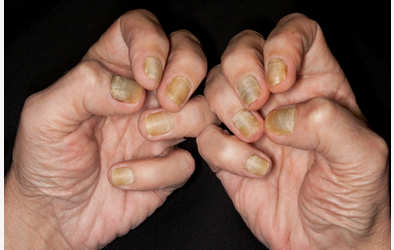yellow nail syndrome
- related: Pulmonary Diseases
- tags: #literature #pulmonology
The findings in this patient of a triad of pleural effusion, lymphedema, and yellow nails coupled with no alternative diagnosis supported by routine testing make the presence of yellow nail syndrome (YNS) most likely. YNS has strong associations with other respiratory system disorders, most prominently chronic sinusitis and bronchiectasis.

YNS is a rare syndrome, most often seen in adults over age 50 years, although even rarer cases have been described in the pediatric population. A few case reports have suggested a genetic predisposition to YNS, but there is general consensus that the great majority of cases are sporadic. There is no specific laboratory test or tissue finding for this diagnosis, which requires exclusion of other disorders such as lupus or thyroid-associated pleural disease and other causes of lymphedema. The nail findings are often striking, with slow-growing nails without cuticle or lunula (the visible part of the root of the nail) that yellow with time; these may be on either or both of fingers and toes. YNS is a rare cause of long-standing unexplained pleural effusions.
The pathophysiology of YNS is obscure. Abnormal development of the lymphatic system is almost always present. Lymphoscintigraphy may show lymphatic obstruction, and some have even recommended surgical bypass of obstructed lymph channels when possible. Impaired lymphatic drainage alone would not explain the exudative effusions that are common in YNS and that were seen in this patient. Exudation of fluid into the pleural space would suggest a degree of capillary leak and/or inflammation, but anti-inflammatory treatment is not generally recommended.
Since YNS is a rare disorder, there have not been controlled trials evaluating treatment. Most experts recommend a conservative initial approach, with the use of compression stockings to reduce leg edema and diuretics to diminish pleural fluid collections. Reports have suggested that vitamin E and azithromycin may have ameliorating effects on the course of YNS. Some patients will have resolution of their effusions and lymphedema with conservative management alone. If pleural effusions recur and are extremely symptomatic, pleurodesis may be required. The emergence of chronic sinusitis or bronchiectasis would warrant treatment directed at these specific disorders. Patients with YNS have not been observed to be at increased risk of malignancy, and this nonsmoking patient with no occupational exposure would not be at significant risk for non-small cell lung cancer or malignant mesothelioma. Emphysema has not been reported to be associated with YNS.